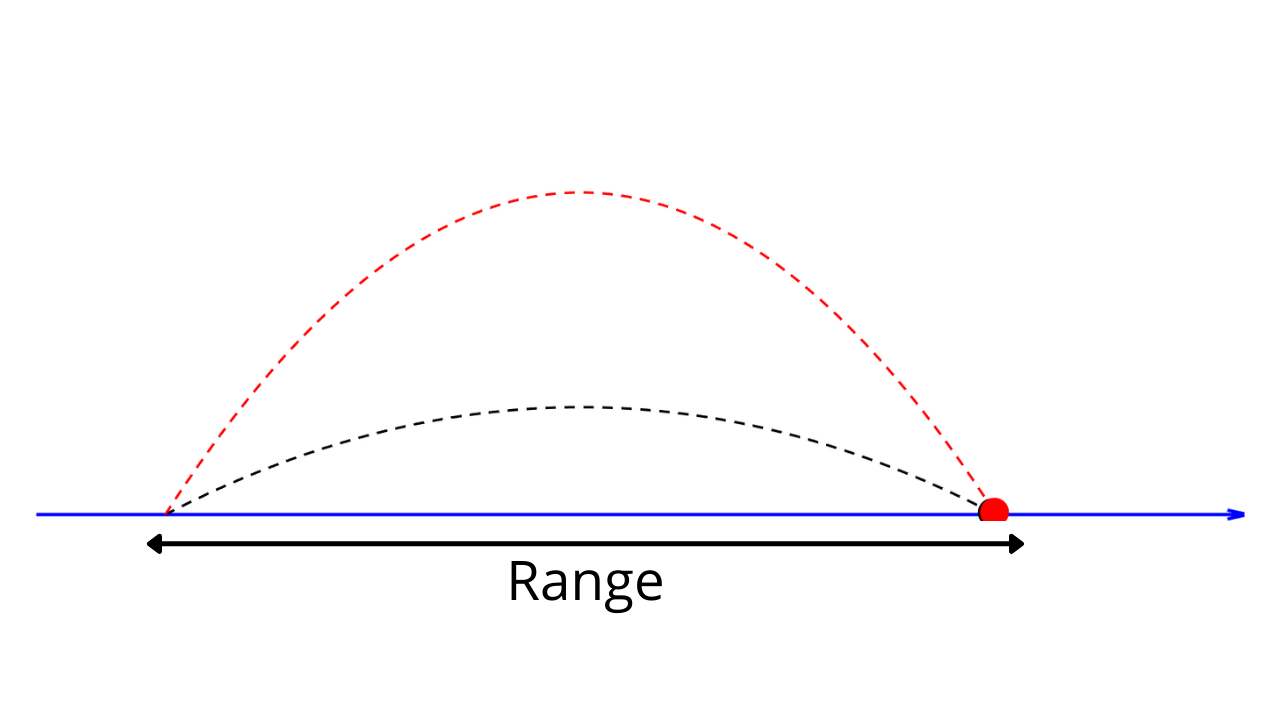Horizontal range of a projectile is the horizontal distance travelled by the projectile between launch and the landing points.
We will begin with an expression for the range for a projectile, projected at an angle $\theta$ on a level ground meaning launch and landing points are at the same height.
Following this we will find out the maximum range of the projectile for a given initial velocity and as we will see it is maximum when angle of projection $\theta = 45^\circ$.
Afterwards we will see that range is same for $\theta$ and $90^\circ – \theta$.
In the end we will find out range when ground is not level meaning landing point is at a different height than the launch point, say in case of horizontal projectile motion
So, let’s start with the expression for the range
Range of Projectile, $R$

Horizontal distance covered by the projectile by the time it returns to the ground is $=u_x \times$ Time of Flight, $T$, where $u_x = u \cos \theta$ is the horizontal component of velocity which does NOT change during the flight as there is no acceleration along the horizontal direction
Time of Flight, $T$, time over which $y$ displacement becomes zero is given by
$0 = u_y T – \cfrac{1}{2} g T^2$ or $T =$ $\cfrac{2 u_y}{g}$ $=\cfrac{2 u \sin \theta}{g}$
which means, Range, $R$ $=\cfrac{2 u^2 \sin \theta \cos \theta}{g}$ $=\cfrac{u^2 \sin 2\theta}{g}$
Maximum Range of Projectile
Now that the range of projectile is given by $R= \cfrac{u^2 \sin 2 \theta}{g}$, when would $R$ be maximum for a given initial velocity $u$. Well, since $g$ is a constant, for a given $u$, $R$ depends on $\sin 2 \theta$ and maximum value of $\sin$ is $1$. So, $R_{max} = \cfrac{u^2}{g}$ and it is the case when $\theta = 45^\circ$ because at $\theta = 45^\circ$, $\sin 2\theta = 1$.
To summarize, for a given $u$, range $R$ is maximum for angle of projection $=45^\circ$.
With that, let’s examine if range $R$ is same for projection angles $\theta$ and $90^\circ – \theta$
Same Range for Two Angles of Projection
Let’s say that range $R$ at projection angle of $\theta_1$ is equal to range at projection angle $\theta_2$, then what is the relation between $\theta_1$ and $\theta_2$
Well this means that $\cfrac{u^2 \sin 2 \theta_1}{g} = $ $\cfrac{u^2 \sin 2 \theta_2}{g}$ or $\sin 2 \theta_1=$ $\sin 2 \theta_2$, which will be true if $2 \theta_2 =$ $180^\circ – 2 \theta_1$ or $\theta_2 = $ $90^\circ – \theta_1$
In other words, for a given velocity a projectile has the same range for $\theta$ and $90^\circ – \theta$.
Range of a projectile launched from a height
Projectile launched from a height at angle $\theta$ with the ground
Assuming that the origin is at the point of launch, let’s say that the time of flight is $T$ (i.e. time it took for the projectile to reach the ground), then
$y$ displacement $=-H=$ $u_y T -$ $\cfrac{1}{2} g T^2$ or $T =$ $\cfrac{u_y + \sqrt{u_y^2+2gH}}{g}$
And horizontal distance covered by projectile during this time, $R$, will be $=u_x T$
Now, let’s see what the expression for $R$ will change to when $u_y=0$, i.e. when projectile is thrown horizontally
Horizontal Projectile Motion
Range $= u \times$ Flight Time, $T$
Time of flight is dictated by vertical motion $H = 0.T + \cfrac{1}{2} gT^2$ or $T= \sqrt{\cfrac{2H}{g}}$
Hence, Range = $= u \sqrt{\cfrac{2H}{g}} $
With that, let’s look at trajectory of a projectile.
Projectile Motion | Important Questions | JEE PYQs
- Types of projectile motion
- Equations of projectile motion
- Range of a projectile
- Maximum height of a projectile
- Trajectory of a projectile
- Radius of curvature of projectile
- Velocity of projectile at time $t$ or height $h$
- Projectile Motion Examples
- Projectile motion along an inclined plane
- Relative motion of projectile(s)
Kinematics Overview – What you need to know for JEE Main and JEE Advanced




